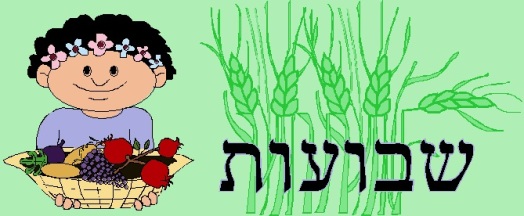
Chag Shavuot Same’ach!
The festival of Shavuot (“Feast of Weeks” or Pentecost), beginning on Motzei Shabbat (Saturday night), is the culmination of the 7 weeks (hence the name) of counting the Omer – Sefirat Ha’Omer. We are instructed by G-d (ויקרא כ”ג:ט”ו – Lev. 23:15) to count, from the 2nd day of Pesach, 7 weeks, at the end of these 7 weeks, a measurement (Omer) of first fruits (bikurim) were brought as a sacrifice to the Temple in a joyous parade.
The one-day festival also commemorates the giving of the Torah to the Jewish People at Mt. Sinai, and we mark this by learning Torah throughout the night (or at least for part of the night), including a special text that is customarily read – the Tikun Leil Shavuot. Synagogues have all-night study sessions, as do schools, youth groups and social groups (including my own women’s group). It is a wonderful feeling to be outdoors in the middle of the night and still see groups of people going to and from their study sessions.
Sivan Rahav Meir (my favourite “Rabbanit” and female Torah scholar/commentator) wrote this lovely Facebook post post earlier today about the meaning of Torah study, and what this experience really feels like – together with a list of shiurim to be given by Petach Tikva’s wonderful (and incredibly energetic, judging by the list of shiurim he will be running to and from over 24 hours!) Chief Rabbi Micha Halevi over Shavuot:
Millions of Jews all over the world will study Torah during the upcoming Holiday of Shavuot. What is the actual meaning of Torah study? What is the difference between this kind of learning and another? Here is a wonderful explanation by Rav Yosef Dov Soloveitchik, of blessed memory, of what happens when we learn Torah:
“When I sit to ‘learn’ I immediately find myself in the fellowship of the sages of tradition. The relationship is personal. Maimonides is at my right, Rabbeinu Tam at the left. Rashi sits at the head and explicates the text. Rabbeinu Tam objects, the Rambam decides, the Ra’abad attacks. They are all in my small room, sitting around my table. They look at me affectionately, enjoy arguing and studying the Talmud with me, encourage and support me the way a father does. Torah study is not solely an educational activity. It is not a merely formal, technical matter embodied in the discovery and exchange of facts. The study of Torah is a staggering experience of generational comradeship, of the mating of spirits, the fusion of souls. Those who transmit Torah and those who receive it meet at the caravanserai of history. Those who transmit Torah and those who receive it meet at the caravanserai (Inn) of history.”
All year long, but especially during the Holiday of Shavuot, we are invited to join in at the historic caravanserai.
On Shavuot we eat dairy foods, for various reasons, including the following possible explanations:
Shavuot celebrates the giving of the Torah to the Jews. Included in the Torah are the laws of kashrut (kosher dietary laws), which tell Jews what can and cannot be eaten and in which combination. For instance, dairy and meat cannot be mixed in the same meal and animals must be killed in a certain way in order to be considered kosher. Before the Torah was given the concept of kashrut did not exist. Hence, one explanation for the eating of dairy on Shavuot is that when the Jews received the Torah they did not have the tools they would need to prepare kosher meat. As a result their first meal after receiving the Torah was a dairy meal. (Mishnah Berurah 494:12; Talmud – Bechorot 6b.)
Another possible explanation has to do with Shir HaShirim (the Song of Songs). Verse 4:11 says “milk and honey are under your tongue” and some have said that the Torah is like the milk in this verse. Like milk, the Torah sustains us. Hence, a dairy meal on Shavuot celebrates the nourishing quality of the Torah.
The Revelation at Sinai (when the Torah was given to the Jews) occurs directly after their Exodus from slavery in Egypt. This journey is described as one “from the misery of Egypt to a country flowing with milk and honey…” (Exodus 3:8-17). Thus, eating dairy on Shavuot commemorates the sweetness of freedom and the new life that lay before the Jewish people.
I have to admit the cheesecake is one of my favourite parts of the festival! 🙂
We also decorate our synagogues and homes with flowers and greenery to commemorate the way that Mt. Sinai burst into flower in honour of the Torah.
In the morning we read Megillat Ruth (the Book of Ruth) in the synagogue for a couple of reasons: the story takes place at harvest time; and more importantly, Ruth, an ancestor of King David, was a Moabite convert who voluntarily became a member of the Jewish nation.
If you would like to learn more about Shavuot, here are some more resources: Judaism 101 and Aish.com.
Wishing my family, friends and all of Am Yisrael Chag Same’ach!




Pingback: Chag Shavuot Same’ach! – 24/6 Magazine